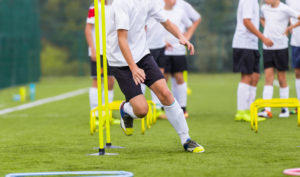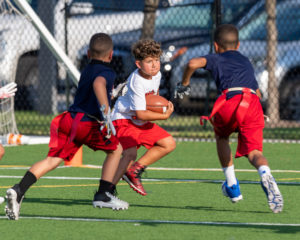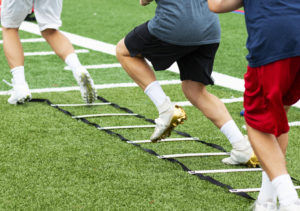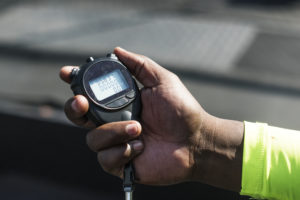Very few athletic traits are valued as much as speed. That’s why the youth “speed training” niche is a near billion-dollar industry in the United States and beyond. Individual coaches and companies have branded themselves as youth speed gurus, supposedly holding the key to unlocking a child’s true athletic potential.
Living up to their claims, most young athletes do get faster under their tutelage. Having coached in this industry for many years, I can honestly say that nearly every athlete I ever worked with learned how to move faster and more efficiently.
So, what’s the secret?
Is it special equipment? Secretive eastern bloc training methods? Proprietary drills that only a handful of elite coaches are privy to?
In actuality, the science of getting kids to move faster and more efficiently is simple. The skillset that youth coaches excel at is applying that science in a way that is fun, effective, and safe for kids.

Consider the challenges involved with running faster. For one, gravity isn’t looking to help the process as it holds athletes’ entire body mass down to the ground. The first thing that needs to happen is to lessen the burden of gravity so athletes can bound from one foot to the other more effectively. In other words, to get faster, young athletes need to get stronger.
Before puberty, research has shown that kids improve strength merely by becoming more coordinated. During and after puberty, muscle size and metabolic factors that influence strength and power play a larger role.
One of the best ways for kids to improve coordination with a movement is to do it, A LOT! The more they do an activity, the more their brain says “Oh! I get it. The movement goes like THIS!” When this happens, the muscles involved with a movement fire faster and more efficiently so overcoming gravity becomes much easier.
Strength specific to running is developed through, well, running. The more time a young athlete can spend doing high- effort running during games, drills, and other activities, the better. Obviously, running activities should be done in a way that prevents overwhelming fatigue. Fatigue is counterproductive to the learning process- particularly for young kids.
The general strength and coordination that aids in the war against gravity can also be developed through progressive resistance training (push-ups, squats, lunges, etc.) involving both the lower and upper body. Nearly everything that supports improved coordination and strength with a young athlete will support improved speed.

To overcome the gravity problem quickly, muscles can’t just be strong, they need to be “elastic.” When a young athlete’s body leaves the ground, it has to come down. When this happens, gravity is accelerating their body downward so when their foot hits the ground, it’s briefly loaded with more than the athlete’s bodyweight. To continue or increase running speed, their muscles and tendons must work together to absorb this force, then quickly return it into the ground. Think “bouncing rubber ball”.
Luckily, there are some natural tendon reflexes that can be trained to help this happen quickly and efficiently. Additionally, muscles can “learn” how to absorb and release energy to become more elastic. When young athletes jump, hop, and generally “bounce” off the ground, they are training these tendons and muscles to act like a rubber ball.
Becoming strong and bouncy is important. However, the “secret sauce” that great coaches understand is how to teach the mechanics of running. As with anything physical, faster running requires an optimal relationship of joint angles, movement timing, and other trainable factors. To move well, feet, knees, hips, torso and shoulders need to be doing the right thing. The more advanced an athlete becomes, the more critical these mechanics become. All the strength and bounce in the world is worthless if it’s not going in the right direction.
To really engrain these mechanics in the brain, it’s important young athletes practice them a lot both during and outside of training.

The once or twice- per-week a young athlete may have an opportunity to work with a coach is only planting a seed for possible improvement. Great coaches get kids excited about the process of learning and inspire them to “practice” outside of training. This practice doesn’t have to be carefully prescribed at-home workouts. Just getting out and finding a reason to run around every day while playing sports or other activities while remembering a few things learned in training can pay huge dividends.
When kids experience success during these activities outside of training, it becomes a positive feedback loop of training, playing, feeling more competent, training with more enthusiasm and focus, playing with more success, feeling more confident, etc.
Special equipment or gadgets themselves do very little for the actual process of speed development. However, if these gadgets or equipment help kids become more engaged and excited about the process of speed development outlined above, they can be valuable. If the special equipment interferes with any of the factors of speed development listed above, it has no value.

For example, from a “purist” standpoint, running with a parachute hasn’t been demonstrated to be an effective method for developing speed in mature athletes. However, kids get far more excited about running with a parachute, so they give more effort. It doesn’t interfere with proper development, so I like using this tool with young athletes.
On the other hand, if a device makes movement look excessively labored and/or awkward, it’s probably ineffective and dangerous. The same could go for any device, activity, or drill that is supposed to be effective, but makes the young athlete feel uncomfortable or inept.
A speed coach or program for kids that focuses on developing strength, elasticity, and movement mechanics in an environment that inspires kids to take what they’ve learned and use it outside of training can unlock a young athlete’s full potential in sports and life.

Brett Klika CEO and co-founder of SPIDERfit is an international award- winning certified strength and conditioning coach, author, and motivational speaker with over 20 years experience motivating and inspiring youngsters to a life of health, fitness, and performance.
Brett consults with schools, athletic organizations, fitness professionals, and fortune 500 companies around the world.





Connect with SPIDERfit!